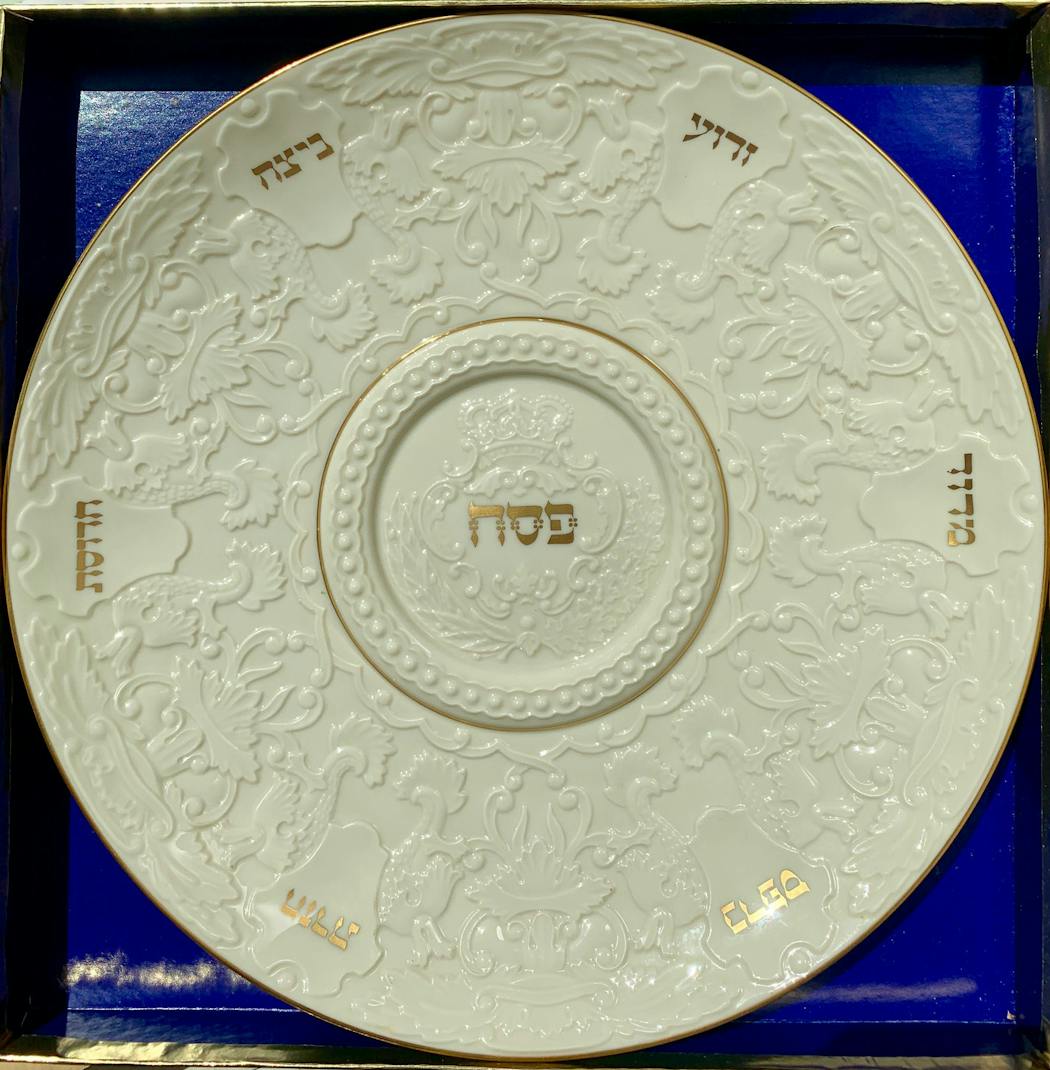There's hardly room for the meal on the table at a seder, the ritual dinner held the first two nights of the Jewish holiday of Passover. There are candles, several bottles of wine, baskets of matzah (unleavened bread), haggadot (the guidebooks, if you will, to the seder), and the most important centerpiece: the seder plate.
Since I started hosting my own seders, about 10 years ago, my table has always been bountiful. But I felt like a scrappy upstart with a little plastic seder plate in the middle. I don't remember where I got the plate — probably on Amazon, a last-minute shopping emergency a few nights before I first hosted a dozen family members and friends. It is marked around its edges with a navy blue pattern resembling Moroccan tile, an inner ring of blue paisley, and gold three-petal flowers. Six depressions hold one of the symbolic foods that tell the story of Passover — parsley and bitter herbs among them — with their names written in Hebrew letters.
On the back, the only information about my plate explains that it is dishwasher-safe.
It doesn't matter that it's plastic, of course. Seder plates come in all materials and forms. Marble, metal, wood, even a series of small bowls can work, as long as it assembles a specific set of foods together as a visual aid for the retelling of the story of Passover, which chronicles Jews' deliverance from slavery in ancient Egypt.
"The seder plate provides a living experience using food as a gateway to conversation about a common event that took place 3,500 years ago," said Rabbi Daniel Ettedgui, of Sharei Chesed Congregation in Minnetonka. "The seder plate, like the seder itself, is probably the greatest lesson plan ever assembled, as far as communicating from one generation to the next."
Those foods might vary depending on evolving traditions wherever Jews have settled. New foods have also been added in modern times, such as an orange that nods to the LGBTQ community.
In Ettedgui's Moroccan family, "the first thing we do when we sit down at a seder is take the seder plate and wave it above each individual's head, around and around in a circular motion. We do that for every individual, so if you've got 25 people at your seder, it can take a while."
To make the ritual go faster, he uses two plates: a ceramic one that was given to his parents by his grandparents, and a copper plate he received as a wedding gift.
My plastic plate was meant to be temporary. And this Passover, which begins Friday night, I am finally retiring it. In its place, I will be using something a little weightier, both in its making and meaning.
My great-grand-aunt Ethel, who passed away at age 98 last year, left me her Lenox china seder plate. According to a note from Lenox in the box, the plate was designed to replicate a 19th-century plate in the collection of the Jewish Museum in New York City. The heavy, cream-colored plate has raised carvings all over it, and the edges are brushed with 24-karat gold.
I don't own a lot of statement pieces, fine china or Judaica items. But the few special pieces I use for holidays are all heirlooms. I have my grandmother's silverware for nice meals, kept in a red velvet-lined chest. My candlesticks are from my mother and grandmother. I have an embroidered cloth I use to cover two loaves of challah on the Sabbath that came from a family friend. And now, Ethel's plate.
There isn't much of a story behind it, according to her son, my cousin Marwin. Sometime in the late 1980s, she had spotted the plate at someone else's seder and wanted one for herself. After the holiday, she went to Fortunoff's department store in New Jersey and bought it on sale for $120 — relatively expensive in those days.
But it wasn't used much because of the raised design on the plate. The charoset, a mixture of chopped fruit, nuts and wine, would get stuck in the nooks and crannies and was too much work to wash it out. My cousin tells me Ethel would place the foods on plastic wrap or in cups to keep the plate clean.
This year, I'll follow Ethel's trick (even though, like my plastic plate, Lenox is, technically, dishwasher-safe).
I celebrated many Passovers with my aunt, and using her seder plate is a way to continue to welcome her to my table. Her memories of her seder plate might have had more to do with the joy of finding it at a great sale than from scrubbing charoset off it. But now that she's left it in my care, it means so much more.
"The passing on of seder plates, and in particular what they hold — their stories — connect one generation in a family to the next," Ettedgui said. "People ask if time travel is possible. I often tell them, 'Do you not see the generation that came before you? It reaches back, just like you can hold hands with each other. Not only with one family but to the family of the Israelite people.' The seder plate is that portal."

An NPR editor who wrote a critical essay on the company has resigned after being suspended


